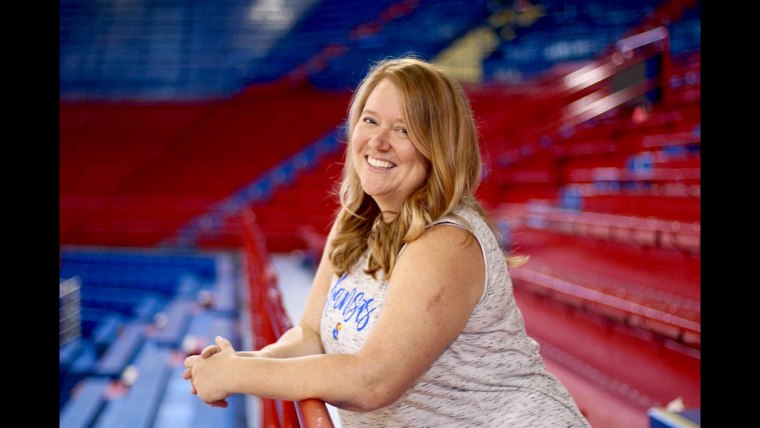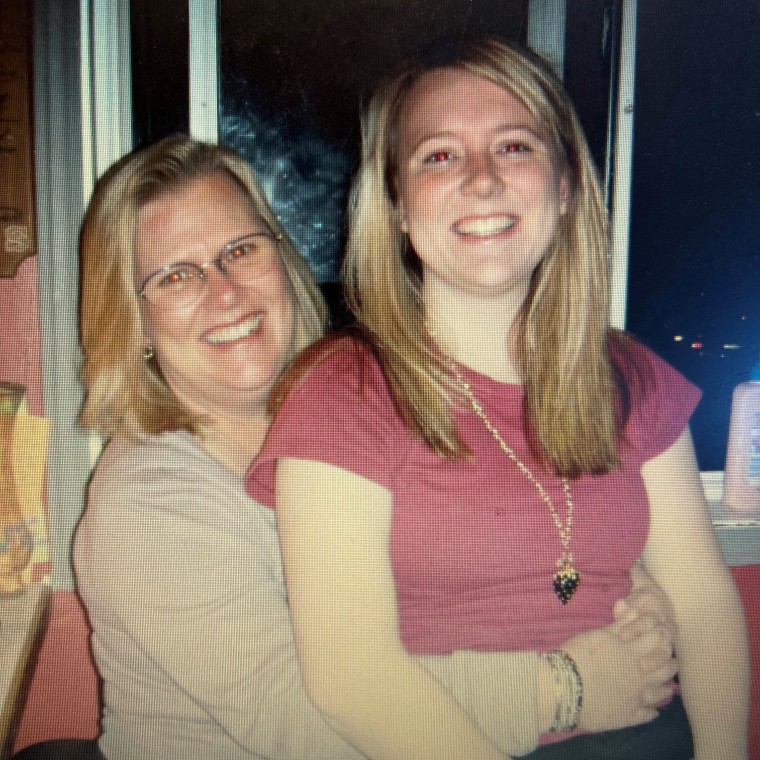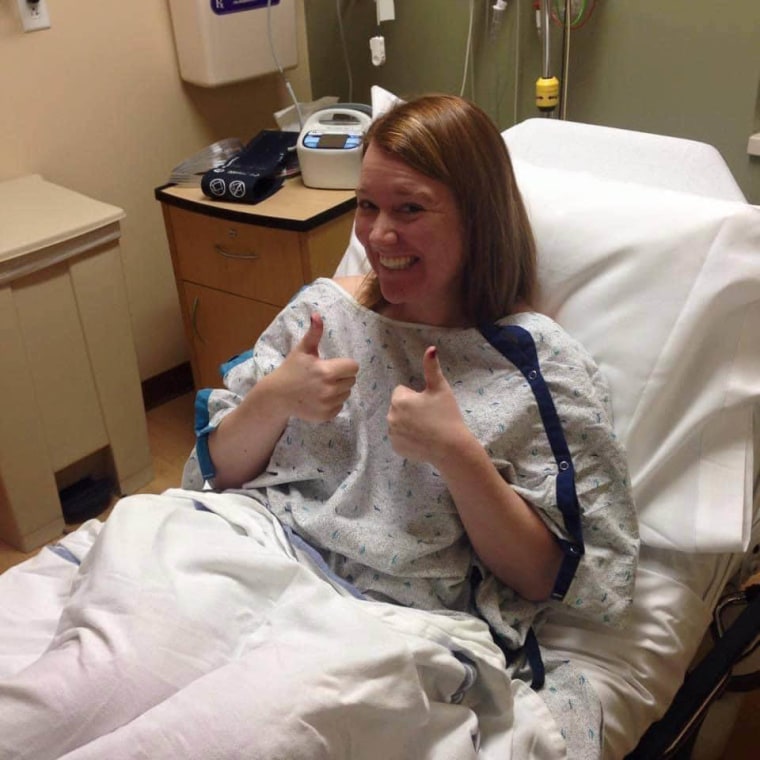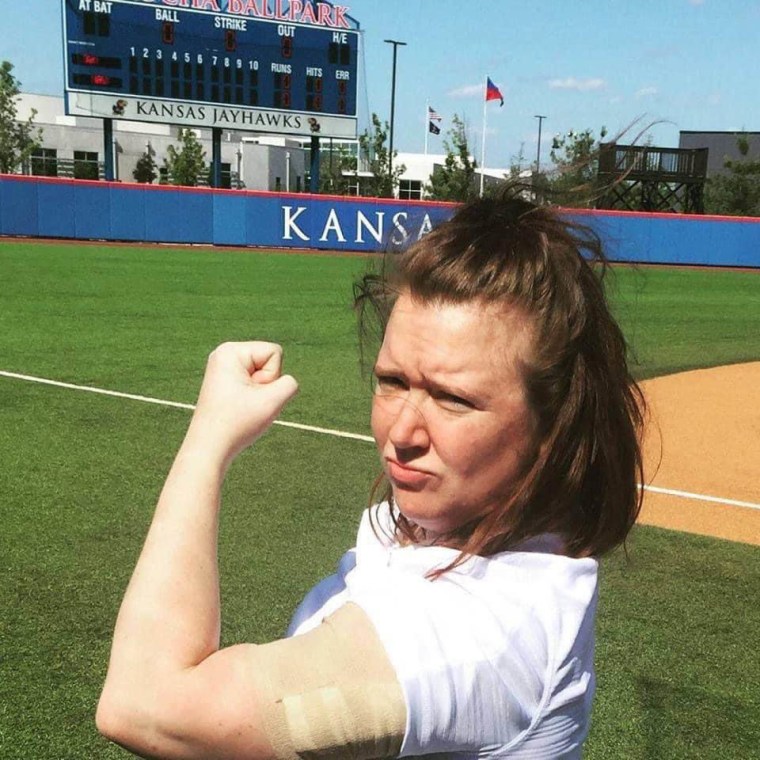Two months after her mom died from melanoma, Theresa Kurtz was stunned to receive her own skin cancer diagnosis.
She had one confirmed melanoma and three severely abnormal moles that were on the verge of turning into it. The ordeal would ultimately lead doctors to remove and biopsy 100 suspicious moles on her body.
Kurtz was just 28 at the time. She had made an appointment to see a dermatologist to fulfill her mom’s wish to go see a skin doctor.
“She had always wanted me to go get checked. It took her death for me to take that seriously,” Kurtz, who lives in Monument, Colorado, and is now 38, tells TODAY.com.
RELATED: Is that mole cancerous? Pictures of melanoma can help you identify what to look for
“I was still grieving my mom and figuring out life without her, and then to hear the same thing — at first, there was a lot of anger. And then I just turned that anger into: How can I tell my story and help other people?”

Melanoma was 'everywhere'
Kurtz has many risk factors for melanoma, including fair skin and red hair, many moles on her body, a family history of the skin cancer and lots of ultraviolet light exposure.
She loves being outdoors and sunburns easily. Working in college athletics, Kurtz has spent lots of time outside at baseball and softball games.
When she was a child, her parents always made her wear sunscreen, but in her teen years, her sunscreen use was hit or miss: “You think you’re invincible and nothing’s going to happen to you,” she recalls.
Kurtz also used tanning beds for about five years, noting “it was all about being tan” when she was in high school and college. In one study, women under 30 were six times more likely to develop melanoma if they tanned indoors.
Kurtz’s family is no stranger to skin cancer: Her mom, Mary, had spots removed that turned out to be melanoma, but she was treated for it and was very proactive about getting regular skin checks, Kurtz says.

Melanoma, the deadliest form of skin cancer, can grow quickly and spread to any organ if not found and treated early, the Cleveland Clinic warns. More than 100,000 new cases of melanoma will be diagnosed in 2024, and more than 8,000 patients will die from it, according to the American Cancer Society.
In the summer of 2014, Kurtz’s mom began to feel unwell to the point where she had to go the emergency room. She thought she had shingles, but scans and tests revealed melanoma in her liver, brain and bones. “It was everywhere,” Kurtz says. Doctors told the family that at some point, an undetected melanoma must have spread to a lymph node and started metastasizing.
Her mom passed away in August 2014, within a month of getting a stage 4 melanoma diagnosis. She was 54.
'I love my scars'
Two months later, honoring her mom’s wish to get a skin check, Kurtz went to a dermatologist.
“I look back, and every day I’m so thankful that I did listen to her, finally,” she says.
Most adults have 10 to 40 moles on their body, but Kurtz has many more. People with more than 50 moles are at an increased risk of developing melanoma, according to the American Academy of Dermatology. (But it’s complicated: A study has also found most patients with melanoma have few moles.)
At that first appointment with her dermatologist in October 2014, the doctor removed and biopsied 28 suspicious moles on Kurtz’s body. One of them turned out to be a stage 0 melanoma, meaning it was still in the top layer of her skin and hadn’t yet grown deeper.
The spot, on her side underneath her right breast, required surgery that left a 9-inch scar.

Three other moles, on her arm and legs, were severely abnormal and also required surgery to make sure the margins were clear.
“I love my scars. For me, it is 100% proof that I’m stronger than what tried to harm me,” she says. “I wear them so proudly.”
Kurtz estimates doctors have now removed and biopsied 100 suspicious spots on her body. Given her family history, she underwent skin checks, blood tests and X-rays every few months for the first five years after her diagnosis to make sure melanoma hadn’t spread. She now gets an annual skin check. It’s been 10 years since any melanoma has been found on her body.
For a while, Kurtz was scared to go outside, but decided she wasn’t going to stop living her life. She still enjoys the outdoors, but always wears sunscreen with a high SPF and reapplies it constantly.

Reflecting on receiving the same diagnosis as her mom, Kurtz says she tries to find a positive in the ordeal.
“I could sit and kind of wallow in the (self) pity of, ‘This is awful.’ But instead, I try to tell my story in hopes that someone else will hear what I heard from my mom and go get checked,” she says.
“I do really hope that someone can hear this and go, ‘Hmm, I probably should go get checked or go to the dermatologist.’”
Melanoma symptoms
Doctors urge people to monitor their skin and pay attention to symptoms, such as the ABCDEs of melanoma — looking for asymmetry, border, color, diameter and an evolving shape — and warning signs, including an "ugly duckling" mole that doesn’t look like any others or a vertical dark streak on a nail.
A history of severe sunburns is associated with a risk of developing melanoma. More than a third of Americans, 36%, had a sunburn in 2023, according to a new survey from the American Academy of Dermatology.
It’s important to seek shade, wear sun-protective clothing, and apply a broad-spectrum, water-resistant sunscreen with an SPF of 30 or higher to protect skin, the academy advises.
